Do you love organizing your life & to-do's with a planner? Join us as we give you insider tips to make the most of your Pray & Plan teacher planner.
Pray & Plan is a planner that helps educators prioritize what matters most - at home, at school, and in their spiritual walk. Get yours here.
listen here:
Planner Tips
I'm excited to bring you some planner tips to help you make the most of your teacher planner, and in particular if you have a copy of Pray & Plan, to make the most of that. If you haven't seen Pray & Plan, its our planner to help Christian educators prioritize what matters most, both at home, at school, and in your spiritual walk.
Pin it for later ⤵
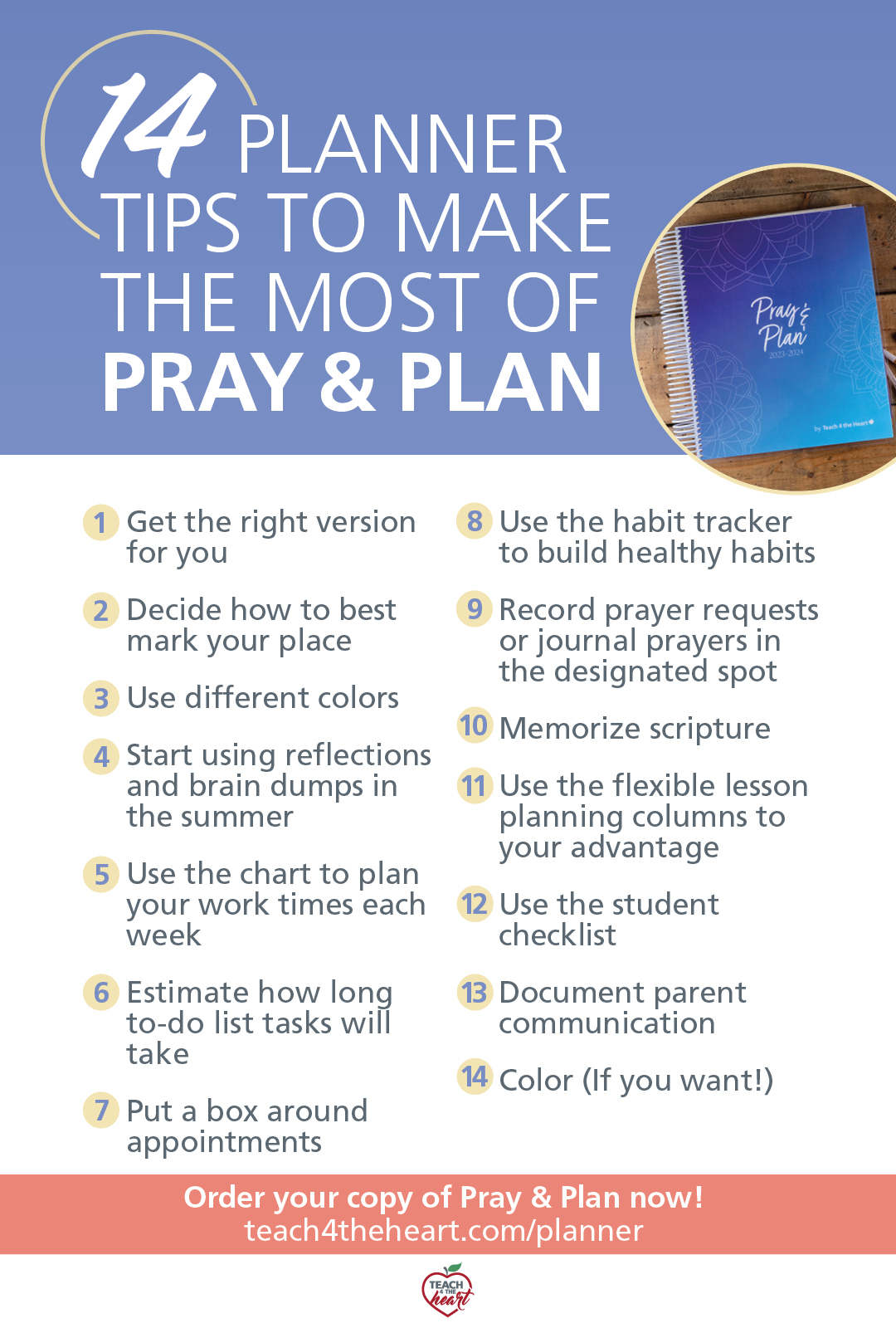
1. Get the right version for you
Both versions of the planner contain the regular planning pages for your to-do list, prayer list, notes, etc. (more about that further down), but there are two versions. One has lesson planning pages and one doesn't. If you do lesson planning on paper, you will want the lesson planning version because it will have everything in one spot for you. It has 50 extra spreads, one for every week of the year, that allow you to lesson plan right in the planner. But if you don't lesson plan on paper (if you lesson plan on the computer, or if you don't teach regularly and don't actually make lesson plans) then you do not need all those extra pages and you want the version without lesson plans.
As you look through the planner pages, if you wish you had more of certain pages or maybe less of others, or if you prefer a three ring binder or disc binding, there is a printable version of the planner available. If you want to customize it a little bit to what you want it to be, add your own pages, take some out, etc., the printable version is for you.
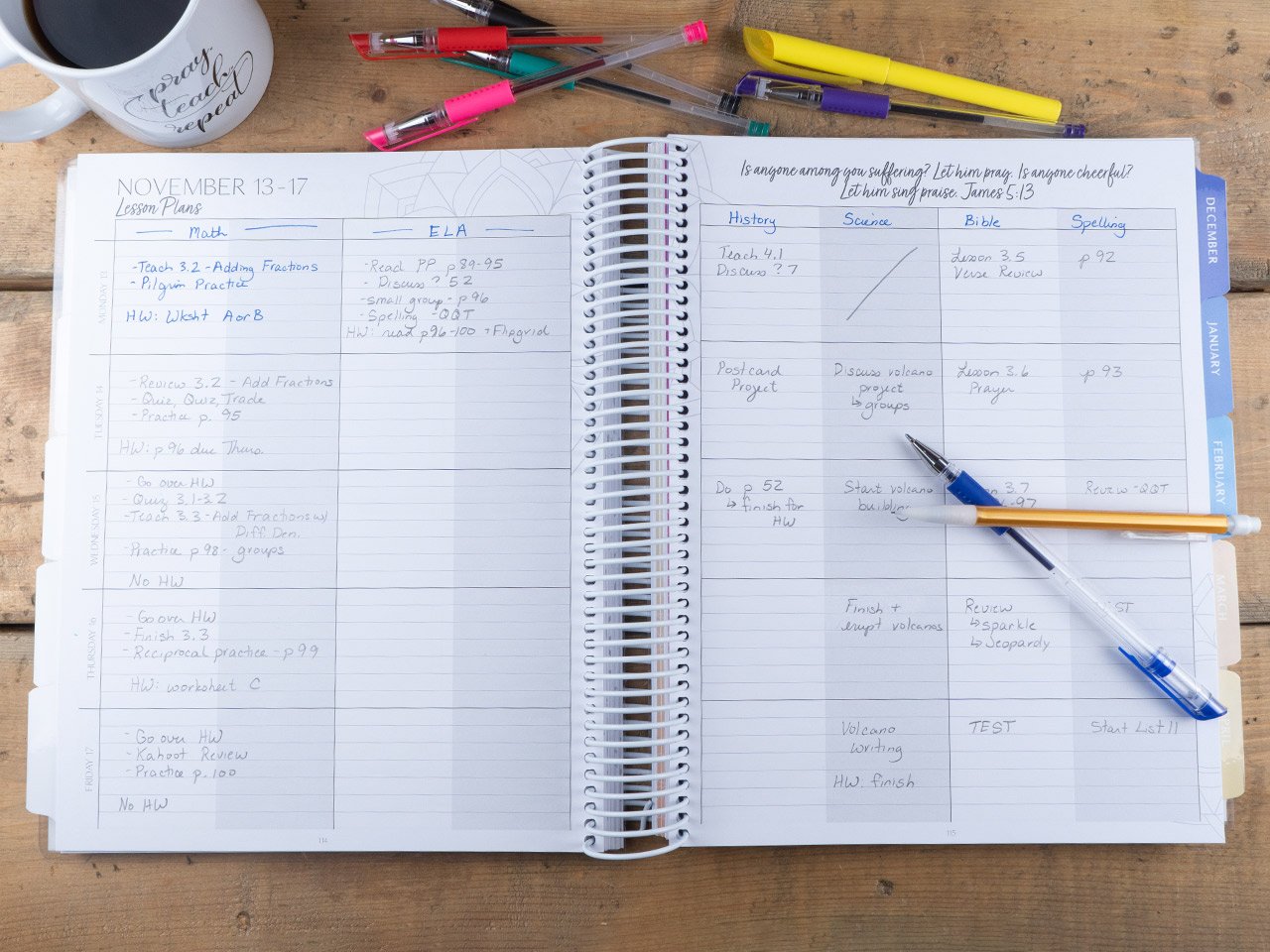
2. decide how to best mark your place
You know if you've used a planner before that you need to be able to find the page you need quickly. So we're really excited to announce that this year we do have a version that has tabs in it for the months. So many of you requested that, so we're excited to offer that as an option this year when you purchase Pray & Plan. But if you choose not to use monthly tabs, then there are some other options. Amazon has movable tabs; they’re pretty affordable and come in a large pack. Check them out here.
Some teachers love to use a magnetic bookmark to mark the page they are on. Another super simple idea is having paper clips or cutting the corner. Once I'm done with the week, I cut off just a little corner and then I can just put my thumb there and it will go right to the newest page, because all of the previous pages have cut corners.
3. USE Different colors
This tip came from a couple of our team members to use different colors of pens for different spheres of your life. So you can have a particular color that you use for anything that relates to home and have a different color for things that relate to school. You can also use different colors if you're working on various projects, or clubs, or want to differentiate between different classes. A lot of times it's helpful in our mind to keep these different parts of our life a little bit separate, yet you need everything in one place in your planner. So using different colors for home and school, or for different projects or tasks, can be a way where you can easily see everything at once, but you can have them differentiated as well.
And by the way, our planner does have thick pages, but to make sure that your pens don't smudge or bleed through, we recommend the Zebra Sarasa gel ink pens. In fact, you can read an article about the best pens for planners here.
4. Start using reflections and brain dumps in the summer
Our planner starts at the beginning of July, and so even though you're not back to school yet at that point, you can start using the reflections already because it's a great habit to get into. The reflection just asks six simple questions:
Concerning the previous month:
- What accomplishment are you most proud of and thankful for?
- What didn't go well and what will you do differently next time?
- What did you spend too much or too little time on?
Looking ahead to the next month:
- What's most important to you in this month?
- What's one thing you need to stop doing, or let go of?
- Who should you pray for or connect with this month?
We also then have a brain dump section, designed for you to clear out your mind and prioritize your to-dos every month. So you brain dump everything that's on your to-do list, both regular and one-off tasks, and then you go through our four "T" process, deciding:
- What am I going to stop doing?
- What am I going to trash?
- What am I going to trim? What am I going to do less of?
- What am I going to get someone to help me with (transfer)?
- What am I going to treasure, to really value?
If you’ve been following Teach4theHeart for a while, you're familiar with this system, but if not you can find out more about it here.
5. Use the chart to plan your work times each week
We had so many questions about what this chart is for in our last version of Pray & Plan. So there's a chart at the bottom of the weekly spreads, and it's there to help you plan your work time. It has symbols for start, stop, and home. What you do here is plan when you’ll start working each day, when you’re going to stop and head home, and when at home you’re going to work in the evenings (if you do).
What's great about this chart is that when we sit down and actually decide with intention ahead of time when we're going to work and when we're not, then it provides so much balance and clarity. It helps keep work from overflowing, but it gives you the flexibility to say, “I've got research papers coming up, I'm going to need some time to grade. I'm going to designate Thursday night from 7:00 to 9:00 for working on research papers.” Then your whole family knows and everyone is on the same page.
6. estimate how long to-do list tasks will take
This is so valuable because when you're sitting down to do the task, it helps you try to keep it in the box of time. If you put down 30 minutes, you're going to try to get it done within 30 minutes. It also helps you be realistic. If you put three hours worth of stuff on Monday and you only have one or two hours to work, that's not realistic. It helps you recognize that ahead of time so you can adjust your plan, rather than trying to get it done and getting frustrated that you can't, when it was never realistic in the first place.
In the planner there are actually two different to-do sections, a weekly to-do and daily to-do, and they're on the same page, so you can see them together. You can choose which you want to use or use both!
7. Put a box around appointments
Taren says, “Put a box around appointments so they stand out from regular to-dos." This makes so much sense because sometimes we put our appointments, like meetings, or doctor's appointments, on our daily to-do list, but they get mixed in with to-dos and we don't realize that we actually have to show up at a certain time at a certain location. So putting a box around them helps them to stand out and make sure they don't blend in and you don't forget them.
8. Use the habit tracker to build healthy habits
This is another new feature of the planner this year. We have a habit tracker section where you can record up to four habits each week that you're working on and check them off. That intentionality alone in choosing to check them off will help you so much to actually build the habit.
9. Record prayer requests or journal prayers in the designated spot
One of my favorite things about Pray & Plan is that it has your to-dos and your prayer life all in one place. We believe our life isn't meant to be fragmented, our faith is meant to be part of everything we do. So there's a spot right here to either jot down prayer requests or to journal a prayer, and there are prayer prompts to help you as well.
10. memorize scripture
You can actually use this planner to help you memorize scripture. There are a couple ways you can do this. There is a spot on the monthly calendar page to choose your own memory verse to write down and memorize. If every time you open your planner to the monthly page, you take just 15 seconds to read that verse, you'll probably have it memorized by the end of the month without even really trying. There's also a verse on each weekly spread, so if you read them every time you look at your planner, chances are you'll have it close to memorized, or at least you'll be meditating on that scripture throughout the week.
11. Use the flexible lesson planning columns to your advantage
If you are using the lesson planning version of Pray & Plan, there is a spread for every week to do your lesson planning. The way the columns are lined up, you can choose to use either four larger columns or eight smaller columns. The nice thing about them is they're all so flexible.
You might need more room to plan certain subjects you teach and then you can use the large columns for that. If you have block classes, you can use the 4 large columns. If you teach 8 classes every day, you can use the 8 smaller columns. So make sure you check that out and if you have any questions about it email us at Linda@teach4theheart.com and we'll be happy to help.
12. Use the student checklist
In the back of the planner, there are student checklist pages, which are just a chart. You can use them as a grade book if you want, but you can also use them to track data, standards, behavior, mastery, or any other data that you need to track. Those are really flexible and you can use them in a variety of ways.
13. Document parent communication
There's also a place in the planner where you can document parent communication, which is so valuable. You don't necessarily need to document all emails because you can just save them in a folder electronically. But when you make a phone call, or you talk to someone in person, there's no documentation about this. So the communication log is just a really easy way to jot a quick note of what you talked about, what day you talked about it, and the resolution that you came to.
14. Color (if you want!)
Pray & Plan is designed with plenty of beautiful elements that you can doodle with or color if you'd like. The Pray & Plan is beautiful without coloring it, so you absolutely do not have to color, but if you do enjoy coloring, there are some beautiful elements on the pages. Then there is also a page each month with a Bible verse that you can color if you want.
one last thing
You'll notice we actually have no tips this year about keeping pages from falling out, or keeping the cover from tearing, because we have updated this version of the planner to make it super durable. So it is now spiral bound, and there's practically no way that pages are going to fall out of the spiral. The cover has been upgraded as well to be laminated with an edge seal. I think you'll find it very, very durable.
So we're so excited for you guys to enjoy Pray & Plan and you can check out more about it here. If you have any other tips for how you use Pray & Plan, or just planners in general, we would love to hear your tips, you can add them in the comments.
The colson center
This podcast episode and blog post is sponsored by The Colson Center. Students learn in the classroom for 12 years, but if God isn't part of the discussion during those years, it's not surprising that our students don't see him as a meaningful part of their lives. The Colson Center believes that God is in control of every square inch of creation, including your classroom, so they created a library of free courses for educators that will provide you with the knowledge and practical skills you need to form your worldview, and that of your students. And a bonus, you're eligible to receive several CEU credits for completing these courses. So check out these free courses at Colson Education.
resources mentioned:
NEED more help with your work/life balance?
Get help in our FREE training: 5 Time-Saving Practices to Stop Feeling Overwhelmed
spread the word!
Did you find this post helpful? Clue in your fellow teachers by sharing the post directly (just copy the URL) or by clicking one of the buttons to automatically share on social media.
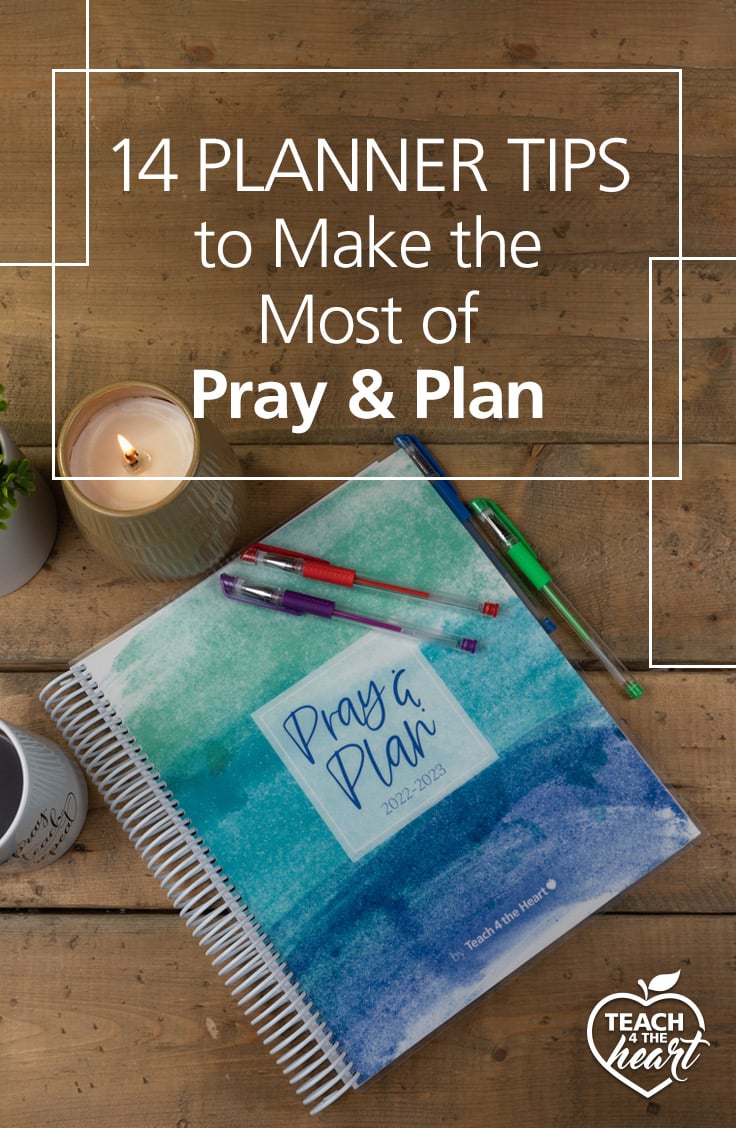
This article may contain affiliate links. This means that if you purchase a resource after clicking the link, Teach 4 the Heart may receive a small commission at no extra cost to you. Thanks for helping support Teach 4 the Heart in this way.


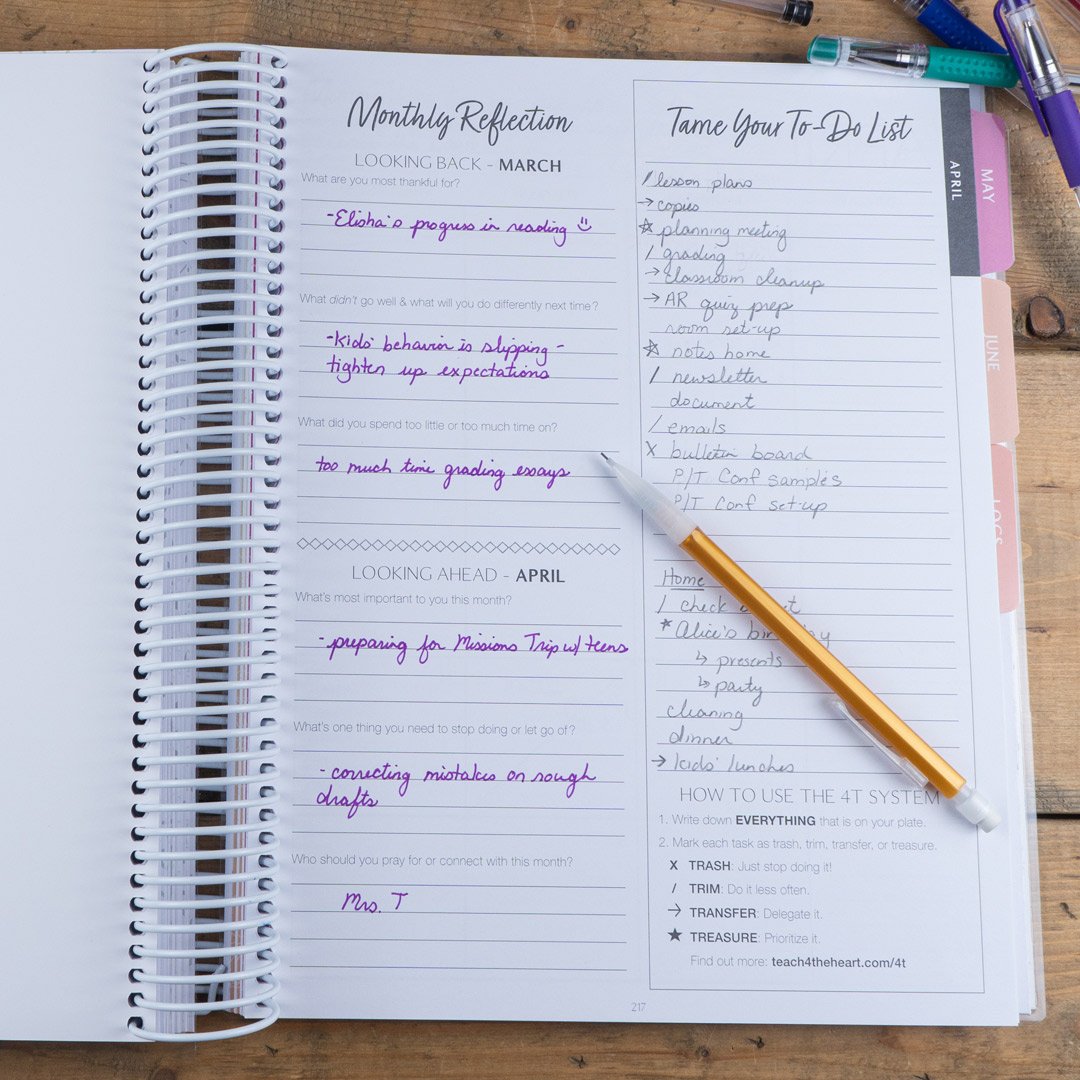

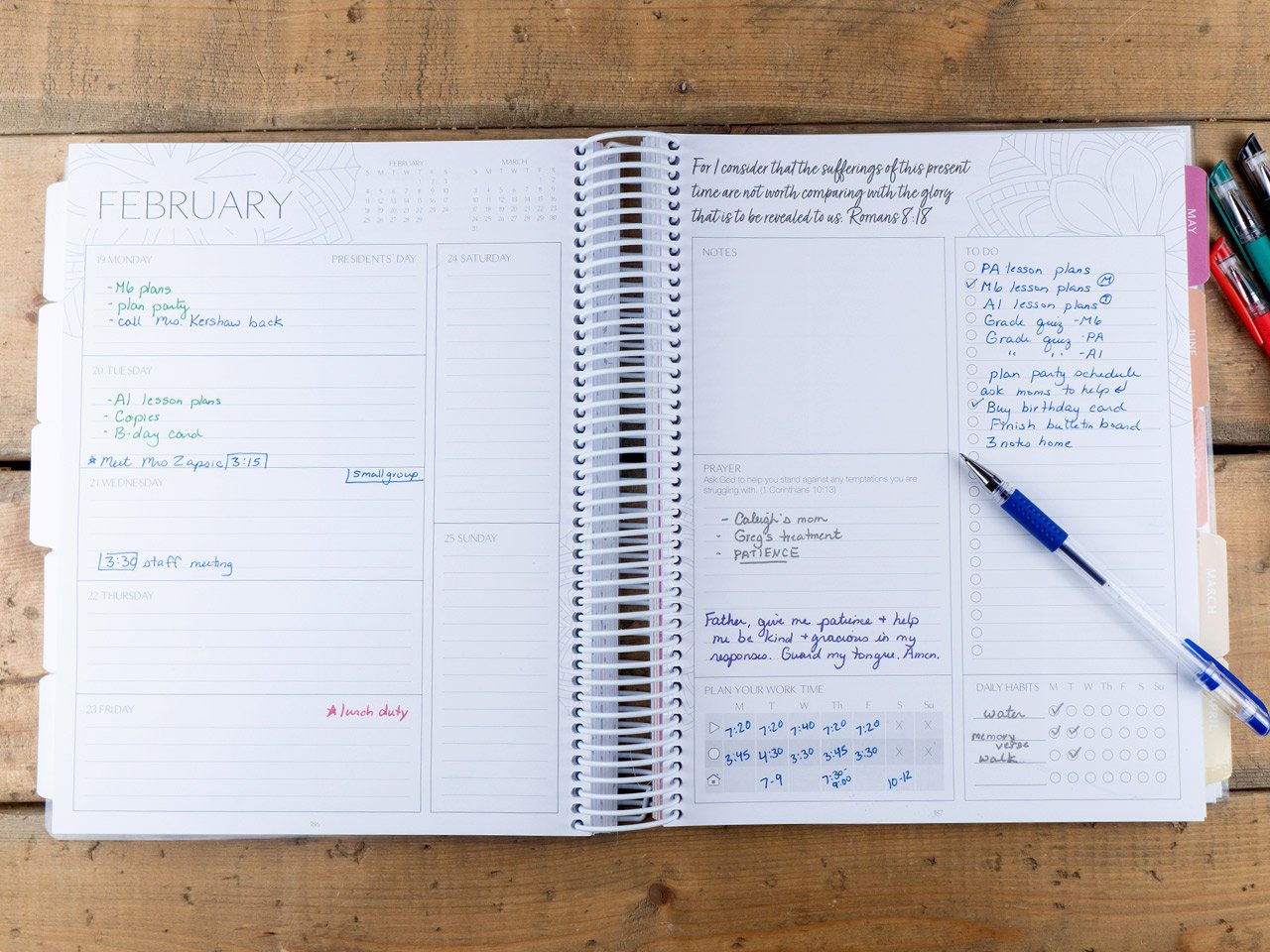




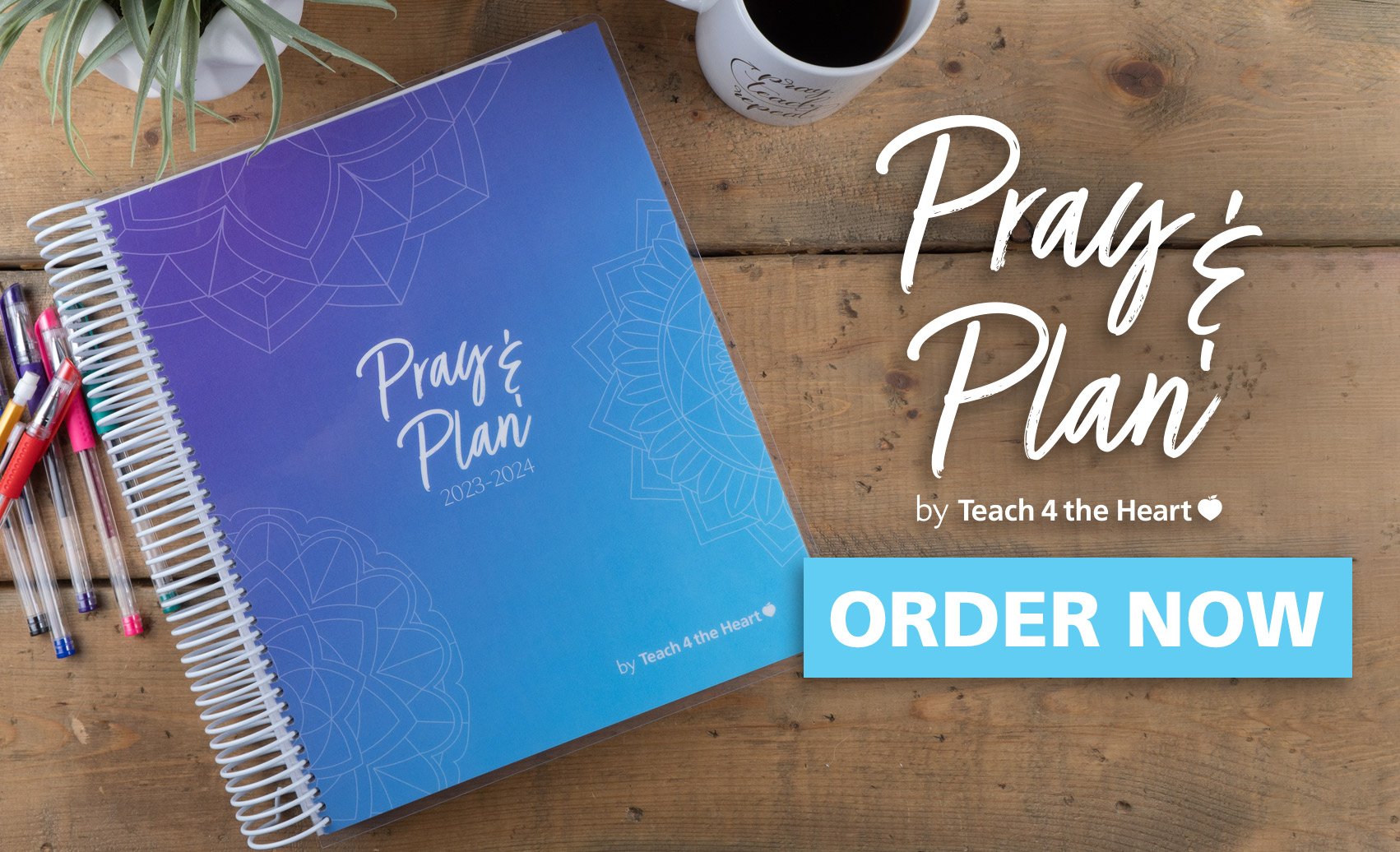

Tip #1: I really like the flexibility of the printable version. I first thought I would like the monthly calendars in front of the weekly plan pages, and after talking with a colleague I decided to rearrange things where I instead have five sections separated by pocket divider tabs: 1) Monthly Calendar, 2) Weekly Planner, 3) Student Checklist, 4) Communication Log, 5) Notes. I like having pocket dividers to have multiple places to neatly tuck handouts/papers. Additionally, I do not always write my lesson plans on paper, so I like the flexibility of choosing to print the lesson planning pages whenever I want to plan on paper without wasting paper I may not use.
I absolutely love the pray & plan teacher planner. I have used a ton of planners but none worked for me but the structure of this one allows me freedom and structure at the same time. I especially love the brain dump and the way each page is set up in a logical way that allows me to record my thoughts to the prompts. I am also a male teacher and it is something that I can use without feeling like it was made for women only. The thing I love the most about it is how it challenges me to love my students as I love myself and spend special time in prayer for my students. This helps me to see my students more as people in need of the love of Jesus Christ.
Thank you so much for sharing!!!
Hi, I’m so happy to have found this Christian planner for teachers! I even want to get one for a teammate so that we can work on the verses together weekly. 💗
Here are a few things I’d love to see in addition to what you already offer…
A customizable cover or more cover options (with your name, a photo, or just different covers like florals, with a scripture).
Optional IEP, RTI, ESL or other specialized pages for students with 504, etc.
I’d love a section with pockets for handouts I might have been given or need to take with me to a meeting.
Also, a clear pocket to add pens, my phone, gum, etc. would be helpful too.
Finally, little attached elastic bands to keep it closed if I have to put it into a bag to take home/travel.
Thanks so much for sharing this feedback!!